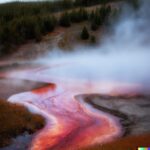Geysers, natural wonders that captivate awe and wonder, hold more than just visual appeal. In this article, we explore the environmental benefits and challenges of geysers.
From geothermal energy production to providing a habitat for unique species, geysers offer a range of advantages. Issues such as water contamination and human impact pose significant challenges. We will also discuss ways to mitigate these challenges, such as proper waste management and responsible tourism.
Join us as we delve into the future of geysers and the potential for sustainable energy production.
What Are Geysers?
Geysers are natural wonders that showcase the spectacular results of geothermal activity in the Earth’s crust.
These impressive features are formed when underground water is heated by magma deep below the Earth’s surface, causing immense pressure to build up. Eventually, this pressure is released in powerful bursts of hot water and steam, shooting high into the air. Geysers are known for their periodic eruptions, creating a mesmerizing display of nature’s forces.
Their unique cyclic behavior sets them apart from other thermal features, making them a highlight in geothermal regions. The excitement of witnessing a geyser erupt is complemented by the stunning landscapes that often surround these natural phenomena.
How Do Geysers Form?
Geysers form through a combination of underground geothermal reservoirs, heat sources, and thermal features that create the iconic eruptive behavior.
As the earth’s crust contains pockets of hot water heated by magma chambers deep below the surface, these geothermal reservoirs act as the primary source of the water and heat needed for geyser formation. The heat transfer mechanisms involved in this process play a crucial role in building up pressure beneath the surface, eventually leading to the explosive eruption of water and steam. The thermal dynamics at play within the geyser system dictate the frequency and intensity of the eruptions, influenced by factors such as water temperature, conduits for steam expansion, and the geological structure of the surrounding rock formations.
Where Are Geysers Found?
Geysers are predominantly found in regions with significant volcanic activity and distinctive geologic formations that support the necessary conditions for their existence.
These dynamic natural phenomena can be observed in various parts of the world, with notable concentrations in areas such as Iceland, New Zealand, and Yellowstone National Park in the United States. The unique combination of underground heat sources, water reservoirs, and geological structures like fault lines contributes to the formation of geysers. In these regions, the interaction between molten rock below the Earth’s surface and water creates the spectacular eruptions that geysers are known for, making them a fascinating attraction for visitors and scientists alike.
What Are the Environmental Benefits of Geysers?
Geysers offer a range of environmental benefits, particularly in the realm of sustainable energy production and conservation efforts.
Their utilization as a source of renewable energy plays a crucial role in reducing greenhouse gas emissions and mitigating climate change. By harnessing the natural heat energy of geysers, communities can decrease their reliance on fossil fuels, thus lowering their overall carbon footprint.
Geothermal power plants powered by geysers have minimal impact on air quality, making them a cleaner alternative to traditional forms of energy generation. This sustainable energy source also aids in the preservation of ecosystems by reducing the need for harmful mining or drilling activities.
Geysers contribute to water conservation efforts by recycling and reusing water in geothermal systems, thereby minimizing freshwater consumption and promoting a more sustainable water management approach.
Geothermal Energy Production
The utilization of geysers for geothermal energy production represents a significant step towards harnessing renewable resources and promoting sustainable energy practices.
This process involves capturing the intense heat generated by underlying geysers and converting it into usable energy through geothermal power plants. By tapping into these natural sources of energy, we can reduce our dependence on fossil fuels, thus decreasing carbon emissions and mitigating environmental harm.
Geothermal energy is a clean and reliable source, providing a consistent supply of power that is immune to the fluctuations in weather conditions that affect solar and wind energy. Embracing geothermal energy helps diversify our energy mix and move towards a more environmentally friendly future.
Natural Habitat for Unique Species
Geysers create unique ecosystems that support diverse flora and fauna, showcasing the importance of conservation efforts in preserving these habitats.
The extreme conditions within geyser ecosystems, such as high temperatures and mineral-rich waters, have led to the evolution of specialized organisms that are uniquely adapted to thrive in these harsh environments. From thermophilic bacteria to heat-resistant algae, these species play a crucial role in the delicate balance of the ecosystem.
Conservation measures are essential to protect these rare and often endangered species from human disturbances and environmental threats, ensuring the sustainability of these remarkable thermal environments for future generations.
Water and Mineral Enrichment of Surrounding Areas
The water and mineral enrichment facilitated by geysers in surrounding areas play a crucial role in supporting local ecosystems and promoting water conservation initiatives.
These natural hot springs, with their unique ability to release heated water and essential minerals into the surroundings, act as nurturing agents for plant and animal life. The presence of geysers not only enhances soil fertility but also creates a dynamic hydrological system that aids in sustainable water resource management. As geysers erupt and spread their mineral-rich waters, they become sources of vitality for the ecosystem, ensuring a balanced and thriving environment for various organisms to flourish.
What Are the Environmental Challenges of Geysers?
Despite their environmental benefits, geysers also pose challenges such as potential environmental impact and disruptions to local ecosystems.
- These natural wonders can release harmful gases like sulfur dioxide and methane, which contribute to air pollution and acid rain, affecting vegetation and water quality.
- The intense heat from geyser eruptions can alter soil composition and disturb delicate ecosystems, posing risks to plant and animal species.
- The sudden outbursts of boiling water can physically damage surrounding habitats and pose safety hazards for both wildlife and humans, highlighting the complex interplay between geothermal activity and environmental conservation.
Water Contamination
Water contamination issues arising from geyser activities highlight the importance of implementing conservation efforts to mitigate the environmental risks and protect water quality.
Geysers, natural wonders that spew hot water and steam, can inadvertently release harmful minerals and chemicals into the surrounding water sources, leading to potential pollution. Without proper conservation strategies in place, such contamination can significantly impact aquatic ecosystems and wildlife, disrupting the delicate balance of these habitats.
To safeguard these environments and ensure the continued availability of clean water for both human consumption and biodiversity, it is vital to monitor geyser activity closely and establish proactive measures to prevent and address any pollution incidents promptly.
Threat to Local Ecosystems
The threat posed to local ecosystems by geyser disruptions underscores the critical need for conservation measures to safeguard biodiversity and ecosystem stability.
Geyser-related activities have the potential to disturb the delicate balance within the ecosystem, leading to ripple effects that can harm plant and animal species. By understanding the intricate web of relationships between organisms and their environment, stakeholders can implement sustainable management practices to mitigate these impacts.
Preserving biodiversity is not just about protecting individual species; it is about maintaining the overall health and resilience of the ecosystem. Ultimately, prioritizing ecosystem protection is imperative to ensure a harmonious coexistence between humans and nature.
Human Impact on Geysers
Human activities near geysers can have detrimental effects on these natural wonders, underscoring the necessity of conservation efforts to minimize human impact and preserve geothermal ecosystems.
When tourists approach geysers too closely or throw items into their pools, it can disrupt the delicate balance of these geothermal features. The natural processes that create the awe-inspiring eruptions may be interrupted or altered, causing long-term harm to the geysers and the surrounding ecosystem.
Conservation initiatives must prioritize education and responsible practices to ensure that future generations can also witness the wonder of these unique geological phenomena. By finding a sustainable balance between tourism, preservation, and ecosystem health, we can protect these natural treasures for years to come.
How Can We Mitigate the Challenges of Geysers?
Mitigating the challenges associated with geysers requires proactive conservation efforts, sustainable practices, and a focus on geothermal sustainability.
Taking steps to conserve these valuable natural resources can help maintain the delicate balance of geothermal systems, preserving them for future generations. By embracing renewable energy technologies and implementing responsible management strategies, we can ensure that geysers remain a sustainable energy source.
Educating communities about the importance of protecting geysers and their surrounding ecosystems is also crucial in fostering a culture of environmental stewardship. Through a collaborative effort that prioritizes conservation and sustainability, we can safeguard these remarkable geological features and reduce the impact of human activity on these unique landscapes.
Proper Waste Management
Implementing effective waste management strategies is crucial to minimize geothermal emissions and ensure the responsible utilization of geothermal technology near geysers.
This emphasis on responsible waste management plays a vital role in mitigating the environmental impact of geothermal energy production. By properly handling emissions and waste products, we can safeguard the surrounding ecosystems and groundwater from potential harm.
Best practices include implementing closed-loop systems to recycle water used in geothermal operations and utilizing advanced technologies to capture and utilize greenhouse gases. These efforts not only reduce the carbon footprint of geothermal projects but also promote sustainability and energy efficiency in the long run.
Conservation Efforts
Conservation efforts play a vital role in protecting geysers, preserving biodiversity, and balancing geothermal exploration with ecosystem conservation.
These initiatives are crucial for maintaining the delicate balance of these natural wonders while also ensuring the sustainability of geothermal activities for future generations. By implementing conservation measures, we can safeguard the unique habitats surrounding geysers, which are home to a diverse range of flora and fauna. Integrating sustainable practices into geothermal exploration not only minimizes environmental impact but also fosters a harmonious relationship between human activities and the natural world. Through these combined efforts, we can actively contribute to the preservation of geysers and the overall biodiversity of the ecosystem.
Responsible Tourism
Encouraging responsible tourism practices around geysers is essential to minimize the impact of visitor activities, support geothermal projects, and foster sustainable geotourism.
- By educating visitors about the fragility of geothermal ecosystems and the unique geological processes that create geysers, we can cultivate a deeper sense of appreciation and respect for these natural wonders.
- Effective site management strategies, such as designated pathways, viewing platforms, and waste management systems, play a crucial role in preserving the integrity of geothermal sites.
- Engaging local communities in decision-making processes and sharing economic benefits can enhance their stewardship of these valuable resources.
What Is the Future of Geysers?
The future of geysers holds promise in terms of expanding geothermal projects, implementing innovative solutions, and advancing sustainable geothermal practices.
- Exploring new geothermal projects not only offers potential for increased energy production but also presents opportunities for economic growth in regions with untapped geothermal resources.
- The integration of cutting-edge technological solutions, such as advanced drilling techniques and improved reservoir modeling, can enhance the efficiency and cost-effectiveness of geothermal exploration and extraction processes.
Embracing sustainable practices, such as reinjection of geothermal fluids to minimize environmental impact and reduce greenhouse gas emissions, is crucial for ensuring the long-term viability of geothermal energy as a clean and renewable power source.
Potential for Sustainable Energy Production
Geysers present a significant potential for sustainable energy production, offering advantages such as reduced climate impact and a renewable energy source.
They play a crucial role in addressing climate change by harnessing the Earth’s natural heat to generate electricity and heat buildings. Geothermal energy from geysers is highly efficient, providing a consistent power supply with lower emissions compared to fossil fuels. This renewable energy source helps reduce reliance on non-renewable resources and contributes to the global effort to reduce greenhouse gas emissions. By tapping into geothermal energy, we can create a more sustainable future while minimizing environmental impact.
Continued Research and Monitoring
Continued research and monitoring of geysers are essential to advance geothermal technology, explore innovative solutions, and ensure the sustainable utilization of geothermal resources.
These ongoing efforts play a crucial role in not only improving the efficiency and performance of geothermal energy systems but also in reducing environmental impacts. By constantly analyzing geyser behavior and geothermal reservoirs, experts can gain valuable insights into optimizing energy production and minimizing disruptions to natural ecosystems. Research also helps in developing cutting-edge technologies that enhance the extraction and utilization of geothermal energy, paving the way for a greener and more sustainable future.
Balancing Conservation and Tourism
Achieving a balance between conservation efforts and tourism development is crucial in managing geothermal infrastructure, promoting responsible geothermal management practices, and preserving geysers.
Geysers are delicate natural formations that require careful preservation to maintain their ecological integrity. Sustainable geothermal practices involve implementing strategies such as controlled visitor access, monitoring of geothermal activity, and education about the importance of conservation. Effective management policies can help regulate tourism activities around geysers while minimizing negative environmental impacts. By integrating ecosystem protection measures, stakeholders can ensure that geothermal resources are utilized in a sustainable manner that benefits both the environment and the local community.
Last Updated on February 7, 2024 by Jon Waraas – Originally Posted: February 7, 2024

I’m Jon Waraas, and I’ve been navigating the online world since 2006. By day, I’m the proud owner of some eCommerce gems, and by night, I’m the voice behind the adventures on Waraas.Com.
My heart, however, belongs to the wild beauty of Yellowstone National Park. I’ve got a collection of websites dedicated to sharing the wonders of this natural masterpiece. Oh, and did I mention? I’m currently building my own cabin inside the ghost town of Gilmore, Idaho – a cabin with tales to tell!
When I’m not immersed in the digital realm, you’ll find me lacing up my boots for a good hike or setting up camp under the star-studded sky.




